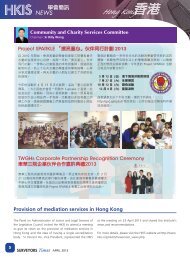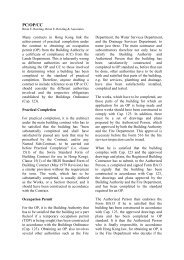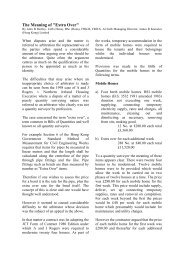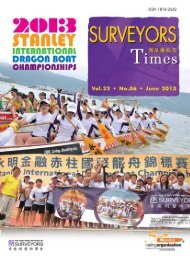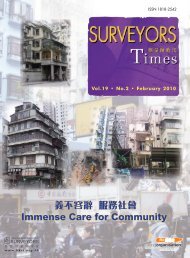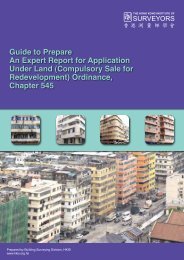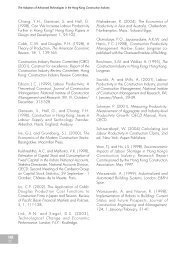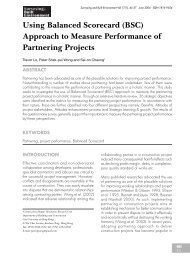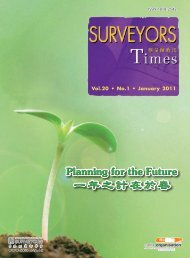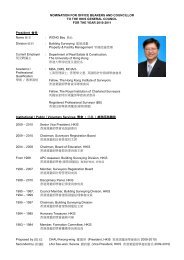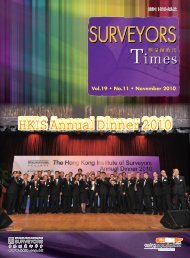Special issue to commemorate the 70th Anniversary of the Battle of ...
Special issue to commemorate the 70th Anniversary of the Battle of ...
Special issue to commemorate the 70th Anniversary of the Battle of ...
You also want an ePaper? Increase the reach of your titles
YUMPU automatically turns print PDFs into web optimized ePapers that Google loves.
Decoding <strong>the</strong> Enigma <strong>of</strong> <strong>the</strong> Fall <strong>of</strong> <strong>the</strong> Shing Mun Redoubt Using Line <strong>of</strong> Sight Analysis<br />
by <strong>the</strong> materials in <strong>the</strong> memoir <strong>of</strong> Lt. General Kitajima<br />
Kineo (1946), Commander <strong>of</strong> <strong>the</strong> First Artillery<br />
Brigade <strong>of</strong> <strong>the</strong> Japanese force that invaded Hong Kong,<br />
and those found in <strong>the</strong> most comprehensive work<br />
published in Japanese, titled Honkon Chosa Sakusen<br />
(1971), which stands for “Hong Kong-Cheung Sha<br />
<strong>Battle</strong>”. 5 This work has detailed descriptions <strong>of</strong> battle<br />
actions and sketch maps <strong>of</strong> battlefields, including one<br />
for <strong>the</strong> Shing Mun Redoubt, which is represented by<br />
a big X with pillboxes at <strong>the</strong> tips <strong>of</strong> each arm <strong>of</strong> <strong>the</strong> X<br />
and sketches <strong>of</strong> <strong>the</strong> pillboxes. Banham’s work (2003)<br />
consolidated information from nearly all English<br />
materials, but did not consult any Japanese or Chinese<br />
materials. The Chinese work by Li (2002), written<br />
roughly at <strong>the</strong> same time, used English, Chinese, and<br />
Japanese sources (including “Cheung Sha”) and is<br />
arguably <strong>the</strong> best Chinese work on <strong>the</strong> <strong>Battle</strong> <strong>of</strong> Hong<br />
Kong.<br />
Table 1: Chronology <strong>of</strong> events leading <strong>to</strong> <strong>the</strong> fall <strong>of</strong> <strong>the</strong> Shing Mun Redoubt on 10 December 1941<br />
Time (date) Events remarks<br />
[Source]<br />
(11 Nov) HQ A Coy 2 Royal Scots moved in<strong>to</strong> <strong>the</strong> Artillery<br />
Observation Post at Shing Mun Redoubt with<br />
Captain C. R. Jones its commander [Cabinet<br />
Office].<br />
00:00 (8 Dec) Invasion began; defenders in positions without<br />
surprise.<br />
08:30 (9 Dec) Lt. Captain H. New<strong>to</strong>n, commanding D Coy 5/7<br />
Rajputs, <strong>to</strong>ok up positions on Smugglers Ridge <strong>to</strong><br />
<strong>the</strong> east <strong>of</strong> <strong>the</strong> Shing Mun Redoubt [Cabinet<br />
Office].<br />
09:00 (9 Dec) Captain Jones contacted Captain New<strong>to</strong>n and <strong>the</strong>y<br />
agreed <strong>to</strong>:<br />
(a) interlock <strong>the</strong>ir arcs <strong>of</strong> fire and<br />
(b) have Captain Jones patrol <strong>the</strong> sou<strong>the</strong>rn slopes<br />
<strong>of</strong> Needle Hill (across Jubilee Dam <strong>of</strong> <strong>the</strong> Shing<br />
Mun Reservoir, which lies right in front <strong>of</strong> <strong>the</strong><br />
Redoubt) [Cabinet Office].<br />
13:00 (9 Dec) Captain Jones went <strong>to</strong> Battalion HQ (at Skeet The Cabinet Office remarked that a<br />
Ground) <strong>to</strong> discuss matters with Lt. Colonel “misunderstanding” occurred <strong>the</strong>n.<br />
S. M. White regarding <strong>the</strong> patrolling <strong>of</strong> <strong>the</strong><br />
Redoubt. [Cabinet Office].<br />
Skeet Ground was located near Castle Peak<br />
Road, Tsuen Wan <strong>to</strong> <strong>the</strong> SE <strong>of</strong> <strong>the</strong> Redoubt.<br />
15:00 (9 Dec) Colonel Doi Teishichi, commanding <strong>the</strong> 228 The Cabinet Office found that Colonel Doi<br />
Infantry Rentai (Regiment), reached Needle Hill met <strong>the</strong> bulk <strong>of</strong> his troops two hours later at<br />
and decided <strong>to</strong> attack eight hours later at 23:00 18:00: <strong>the</strong> time difference was not<br />
[Banham, Lindsay].<br />
considered material.<br />
Colonel Doi met <strong>the</strong> 3rd Taitai (Battalion)<br />
Commander, Major Nishiyama, and agreed<br />
<strong>to</strong> attack at night [Cheung Sha; Fujita<br />
Tachio].<br />
17:30 (9 Dec) Colonel Doi’s assault troops were within 500<br />
5<br />
The Japanese lost <strong>the</strong> first three <strong>Battle</strong>s <strong>of</strong> Cheung Sha during <strong>the</strong> Sino-Japanese War. All three defeats came at <strong>the</strong> hands <strong>of</strong> <strong>the</strong> Nationalist<br />
Chinese Army. The Japanese treated <strong>the</strong> <strong>Battle</strong> <strong>of</strong> Hong Kong as part <strong>of</strong> <strong>the</strong> bigger picture <strong>of</strong> <strong>the</strong>ir first attempt <strong>to</strong> capture Cheung Sha.<br />
SBE<br />
24



